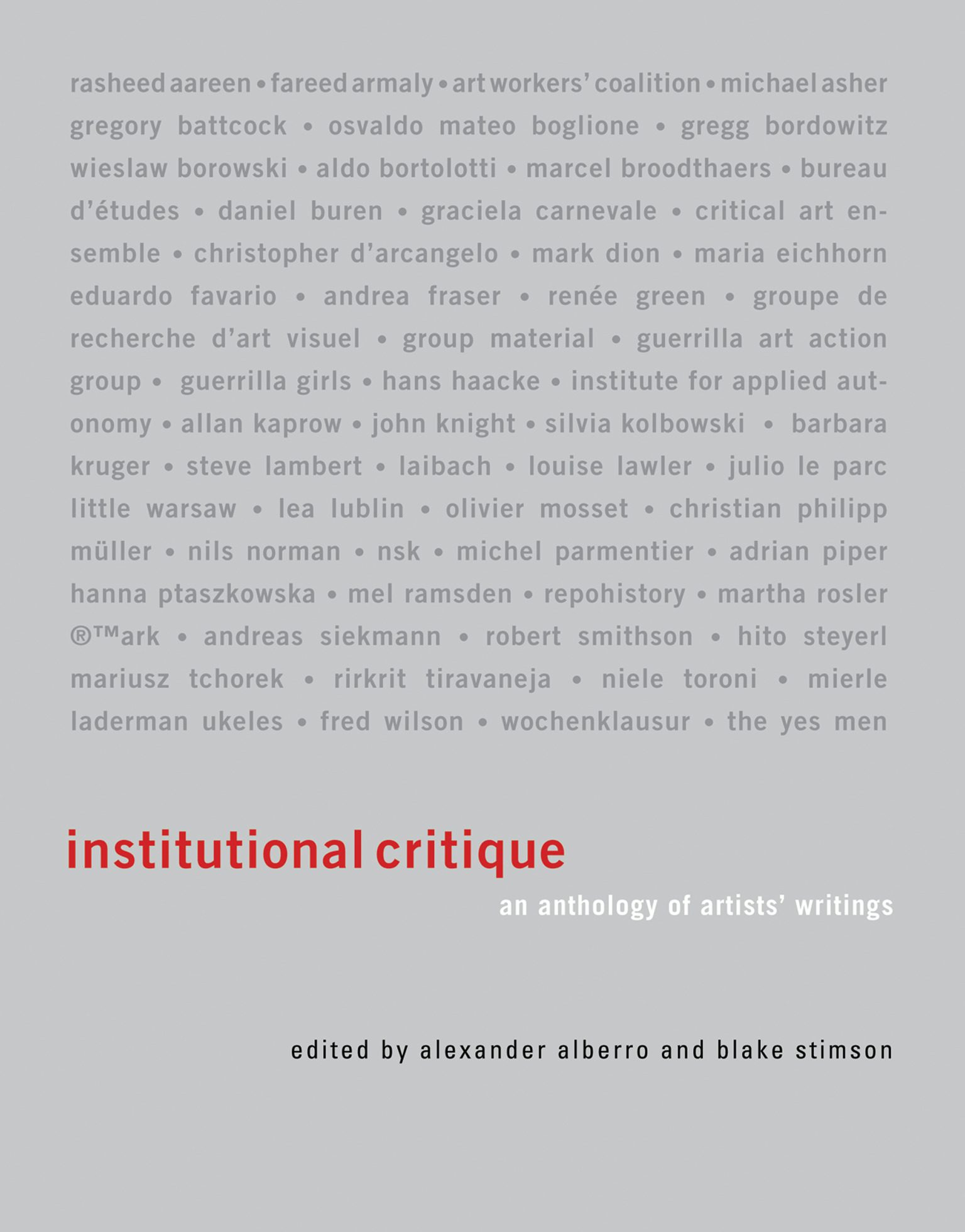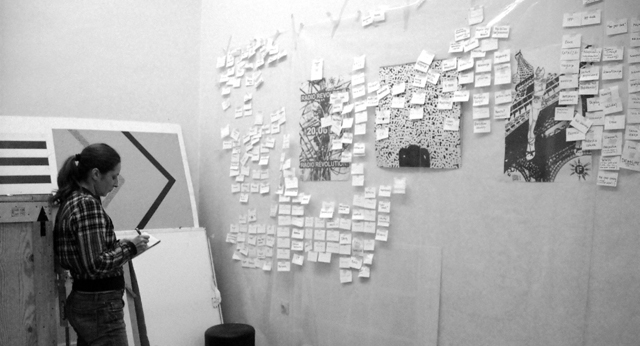Alexander Alberro, Blake Stimson (eds.): Institutional Critique: An Anthology of Artists’ Writings (2009)
Filed under book | Tags: · art, art criticism, art history, art system, art theory, artistic research, contemporary art, critique, institutional critique

“‘Institutional critique’ is an artistic practice that reflects critically on its own place within galleries and museums and on the concept and social function of art itself. Such concerns have always been a part of modern art but took on new urgency at the end of the 1960s, when—driven by the social upheaval of the time and enabled by the tools and techniques of conceptual art—institutional critique emerged as a genre. This anthology traces the development of institutional critique as an artistic concern from the 1960s to the present, gathering writings and representative art projects of artists who developed and extended the genre. The artists come from across Europe and throughout North America. The texts and artworks included are notable for the range of perspectives and positions they reflect, and for their influence in pushing the boundaries of what is meant by institutional critique.
Like Alberro and Stimson’s Conceptual Art: A Critical Anthology, this volume will shed new light on its subject through its critical and historical framing. Even readers already familiar with institutional critique will come away from this book with a greater and often redirected understanding of its significance.”
Artists represented include: Wieslaw Borowski, Daniel Buren, Marcel Broodthaers, Groupe de Recherche d’Art Visuel, Hans Haacke, Robert Smithson, John Knight, Graciela Carnevale, Osvaldo Mateo Boglione, Guerilla Art Action Group, Art Workers’ Coalition, Mierle Laderman Ukeles, Michael Asher, Mel Ramsden, Adrian Piper, The Guerrilla Girls, Laibach, Silvia Kolbowski, Andrea Fraser, Fred Wilson, Mark Dion, Maria Eichhorn, Critical Art Ensemble, Bureau d’Études, WochenKlausur, The Yes Men, Hito Steyerl, Andreas Siekmann
Publisher MIT Press, 2009
ISBN 0262013169, 9780262013161
492 pages
PDF (10 MB, no OCR; updated on 2023-2-14)
Comments (2)Anti-Jargon: Terms of Deschooling Classroom (2009-) [English, Serbian, Macedonian]
Filed under pamphlet | Tags: · art, art theory, contemporary art, education, self-education

“Terms is a group that studies terms in the field of contemporary artistic, theoretical, cultural and educational practice from the perspective of practitioners active on the independent cultural scenes of Skopje and Belgrade through the process of self-education. The aim of the group work was not to create yet another glossary, vocabulary or lexicon, but rather to establish a relational web of concepts in most frequent use. We either comprehend them differently or are, simply, unaware of the different readings according to one’s assumed theoretical (or ideological) position. Investigating the origin, epistemology and the politics of a term, we come to a non-implied, non-colloquial – anti-jargon term platform. By jargon we imply fast, specialized communication, with implied meaning but is actually completely empty. There is no implied meaning behind used terms, instead they only represent an affiliation to the moment, profession, ideology… This position is not a result of some kind of idealistic search for ‘authentic’, ‘original’ meaning of the word. On the contrary, it is a search to establish the term and the politicality of its use in the contextual, historically-materialistic sense. In addition, our intention is not only to detect and demonstrate the mechanism of jargon or to claim that we are excluded from it. The work on de-jargonisation we also view as affirmation of new terms. The new terms can be subjected to de-jargnisation as a prevention.
In this publication we offer the registry as a format for de-jargonisation – it is a simple table that is also one of the algorithms for using this publication. Origin, history, utilization, references and ‘description’ are determined for terms used in this table. ‘Description’ can be a note, artistic statement, a list of other terms, or something close to a lexicon entry. The entries in the table link to texts in the publication and outside of it – and thus create relational network of terms and definitions, virtually unlimited hypertextual structure. Publication is open in content and structure, and its real purpose is achieved if the users – editors/authors/readers – continue to work on it: filling in, adding, reediting and using it. That’s why we leave the registry unfinished, demonstrating the possible ways and formats of its use, and invite you to cooperate with is on making it grow.”
Terms: Artistic Immunity, Contexterin, Contextual art in the countries of Eastern Europe: Approaches, diagnoses and treatments of the problems, Festivals Classification, The Festivals (in the ex-Yugoslavia region) as a “microphysics of power” (Foucault), How my Life Turned into a Festival, Potentiality, Soros Realism
Working group: Milena Bogavac, Dragana Bulut, Bojan Đorđev, Anđela Ćirović, Siniša Ilić, Aleksandra Jančevska, Boris Krmov, Milan Marković, Katarina Popović, Biljana Tanurovska-Kjulavkovski, Ljiljana Tasić, Ivana Vaseva, Elena Veljanovska, Dragana Zarevska.
Comment (0)Claire Bishop (ed.): Participation (2006)
Filed under book | Tags: · aesthetics, art, art criticism, art history, art theory, audience, participation, politics, relational aesthetics

“The desire to move viewers out of the role of passive observers and into the role of producers is one of the hallmarks of twentieth-century art. This tendency can be found in practices and projects ranging from El Lissitzky’s exhibition designs to Allan Kaprow’s happenings, from minimalist objects to installation art. More recently, this kind of participatory art has gone so far as to encourage and produce new social relationships. Guy Debord’s celebrated argument that capitalism fragments the social bond has become the premise for much relational art seeking to challenge and provide alternatives to the discontents of contemporary life. This publication collects texts that place this artistic development in historical and theoretical context.
Participation begins with writings that provide a theoretical framework for relational art, with essays by Umberto Eco, Bertolt Brecht, Roland Barthes, Peter Bürger, Jen-Luc Nancy, Edoaurd Glissant, and Félix Guattari, as well as the first translation into English of Jacques Rancière’s influential “Problems and Transformations in Critical Art.” The book also includes central writings by such artists as Lygia Clark and Hélio Oiticica, Joseph Beuys, Augusto Boal, Felix Gonzalez-Torres, Thomas Hirschhorn, and Rirkrit Tiravanija. And it features recent critical and curatorial debates, with discussions by Lars Bang Larsen, Nicolas Bourriaud, Hal Foster, and Hans-Ulrich Obrist.”
Publisher Whitechapel, London, and MIT Press, 2006
Documents of Contemporary Art series
ISBN 0262524643, 9780262524643
207 pages
PDF (updated on 2017-6-19)
Academia.edu (added on 2015-5-6)

